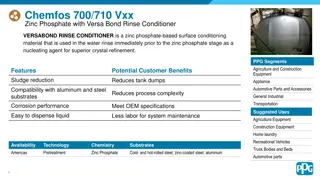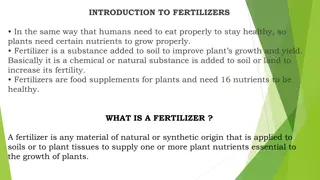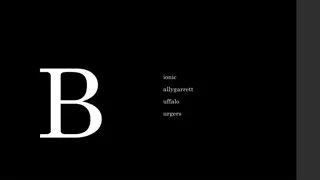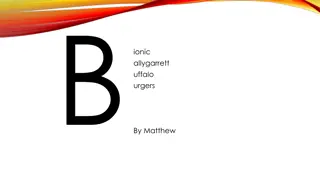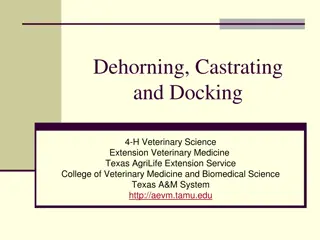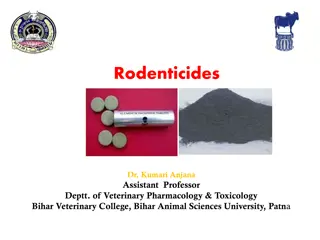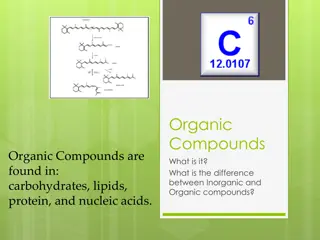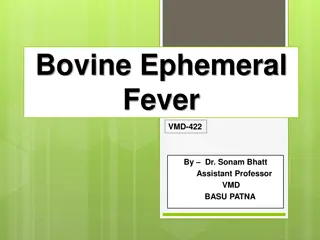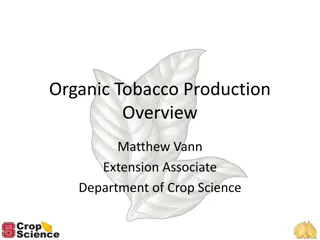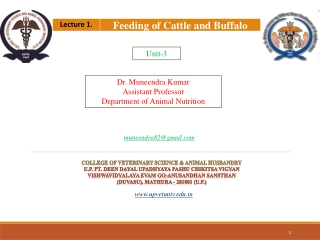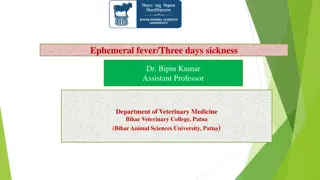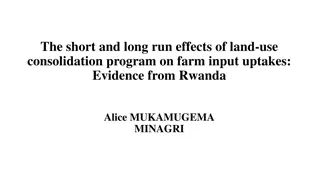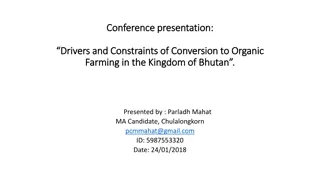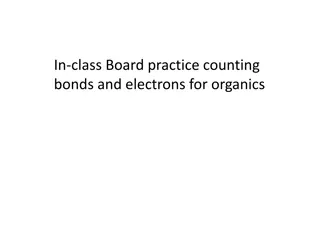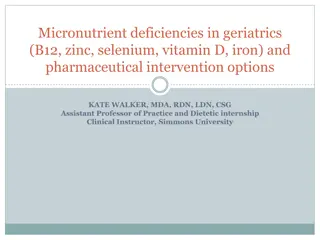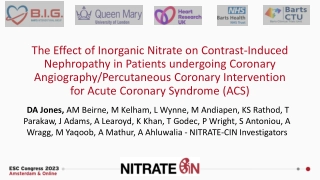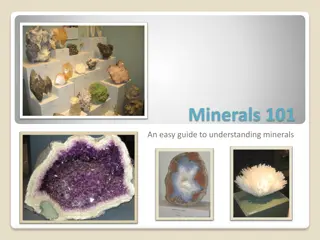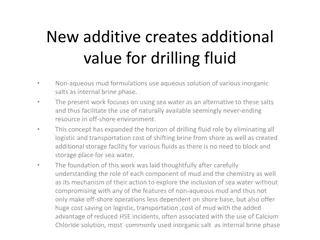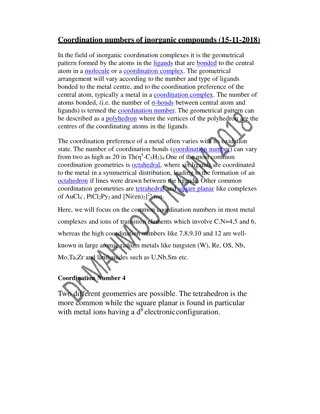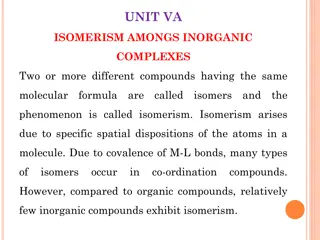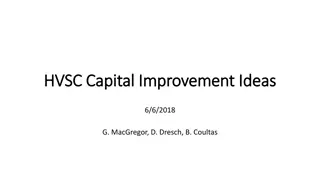Impact of Replacing Inorganic Zinc with Organic Zinc on Buffalo Calves
The study explores the effects of replacing inorganic zinc with a lower level of organic zinc (zinc propionate) on performance, biochemical constituents, and mineral status in buffalo calves. Zinc deficiency is a critical issue affecting growth, immunity, and reproduction in livestock. Inorganic mineral supplementation poses challenges like low bioavailability and potential contaminants, leading to uncertainties in meeting nutrient requirements. The research aims to address these issues by evaluating the impact of organic zinc supplementation on buffalo productivity.
Download Presentation

Please find below an Image/Link to download the presentation.
The content on the website is provided AS IS for your information and personal use only. It may not be sold, licensed, or shared on other websites without obtaining consent from the author. Download presentation by click this link. If you encounter any issues during the download, it is possible that the publisher has removed the file from their server.
E N D
Presentation Transcript
EFFECT OF REPLACING INORGANIC ZINC WITH A LOWER LEVEL OF ORGANIC ZINC (ZINC PROPIONATE) ON PERFORMANCE, BIOCHEMICAL CONSTITUENTS AND MINERAL STATUS IN BUFFALO CALVES D. Nagalakshmi Professor & Head Department of Animal Nutrition College of Veterinary Science Korutla, Karimnagar- 505 326
Introduction Major contributor of milk (55% of total) India -first in buffalo population - 56.3% of world population Buffalo productivity- compromised- great economic loss to farmers Causes: Poor Low growth rates High calf mortality Issues: reproductive efficiency Nutritional Managemental
Nutrition Min. & Vit. deficiency affect the appetite, growth, immunity & reproduction Trace mineral deficiency (Zn, Se, Mn & Cu) - ovarian inactivity, decreased immune response & growth Zn, Cu & Se integral component of antioxidant system in body Trace mineral deficiency are mostly submarginal to marginal
Zinc- an important mineral Zn is very critical mineral Need to optimize requirements of Zn for proper growth, immune response and reproduction Half of soils in world are Zn deficient (Nielson,2004) Same is reflected in feeds & fodder & hence animals Concentration of Zn in livestock feeds & fodders is critically deficient in AP (Nagalakshmi et al., 2007 & 2009) and most parts of the country (Gowda et al., 2009)
Form of mineral supplementation Inorganic form (sulphates, oxides, carbonates, chlorides) Organic form (chelated minerals) Inorganic minerals Relatively cheaper Readily available Form the basis of NRC mineral requirement
Problems with inorganic minerals Low bioavailability 4-22% Variable availability in market Presence of contaminants (Heavy metals: ZnO & CuSO4 are from residues of steel industry (have high levels of Cd, F and Pb) Purity of inorganic salts in market Various processing conditions used in manufacturing likely reduce biological availability These uncertainities: inorganic minerals supplemented 2-10 times NRC requirement
Excess supplementation of Inorganic minerals Damage in nutrient absorption Reduces mineral bioavailability Causes environmental pollution (soil & ground water) Led to focus on chelated/organic minerals
Organic/chelated minerals Complexing inorganic element with organic compound (amino acid(s), peptides, proteins, polysaccharides, organic acids, vitamins) Chelation- complex formed between an organic molecule and a metallic ion. Metal held with in the organic molecule as if by a claw . Chelate -Greek word - Claw Naturally occurring chelates : Chlorophyll, Cytochrome, Haemoglobin, Vitamin B12
Mineral absorption in gut Mineral absorption in gut Excretion Antagonist + Metal & Mineral Interactions Free metal ion Ligand + Metal Enterocyte Absorption
Mutual antagonism Major factor in reducing mineral absorption & metabolic rates Mn & Fe compete for similar absorption mech. Competition of same or similar carrier protein Replacement of 1 metal by another in metalloenzyme molecule affects efficiency Mo- impairs absorption of Cu & vice-versa Ca- impairs absorption of Cu, Zn
Advantages of organic minerals Reduction of antagonism, interferences and competition among minerals. Improve the bioavailability of minerals (1.2-1.85 times higher than inorganic) Counteract antinutritional factors that affect mineral utilization Hence improvement in performance, health & reproduction Protect environment by reducing metal pollution. 1. Metal (specific amino acid) Complex 2. Metal Amino acid Complex Types 3. Metal Amino acid Chelate 4. Mineral proteinates 5. Mineral polysaccharide complex 6. Metal organic acids
Metal organic acids Metal propionate Resulting of combining soluble metals with soluble organic acids like propionates Zn-propionate P PA Acid Zn
Organic minerals are costly compared to inorganic source 1. To supplement at lower concentration than the standard recommendation 2. To replace a portion of inorganic minerals with organic source
Experimental Design Animals 12 buffalo calves (9-15mon. age) Dietary treatments 2 (6 animals in each group) Diets (sorghum stover based complete diet) 1. 80ppm Zn supplementation- ZnSO4 2. 60ppm Zn supplementation- Zn-prop Duration 120 days Design CRD
Composition of basal diet Ingredient Composition (%) Sorghum stover 40.0 Maize 40.0 Soyabean meal 6.5 Molasses 8.5 Red gram chunni 1.41 Urea 1.0 Limestone powder 0.8946 Mono-calcium phosphate 1.3503 Salt 0.2086 Trace mineral and vitamin premix* 0.2079 Zinc (ppm) 29.72 *Trace mineral premix provided (mg/kg diet): Iron, 41; manganese, 21; copper, 10; cobalt, 0.1; Iodine, 0.27; selenium, 0.3. Vitamin A, D and E were provided to supply 2927 IU; 1097 IU and 39 IU per kg diet, respectively.
Zinc propionate supplementation on fortnightly body weight in buffalo calves Attribute Start First Second Third Fourth Fifth Sixth Seventh Eighth Weight gain (kg) ZnSO4-80 195.6 202.1 201.6 208.0 210.2 225.6 234.7 245.8 257.4 61.75 Zn-prop-60 191.0 195.4 195.8 204.1 204.8 216.4 226.5 238.2 256.0 65.00 SEM 68.00 66.78 65.51 67.83 62.46 66.02 68.26 70.73 70.99 10.649 P value 0.912 0.870 0.887 0.925 0.888 0.821 0.847 0.861 0.975 0.621
Zinc propionate supplementation on performance in buffalo calves Attribute ZnSO4-80 Zn-prop-60 SEM P value Start BW (kg) 195.6 191.0 68.00 0.912 End BW (kg) 257.4 256.0 70.99 0.975 ADG (g) 514.6 541.7 88.742 0.621 FCR 9.83 9.75 1.859 0.943 DMI/100kg BW (kg) 2.42 2.53 0.562 0.758
Zinc propionate supplementation on serum biochemical constituents in buffalo calves Attribute ZnSO4-80 Zn-prop-60 SEM P value 11.85a 25.23b 9.040 0.003 ALP (U/L) 5.81a 7.97b 2.077 0.069 Total protein (g/dl) 2.43 4.35 2.115 0.120 Globulin (g/dl) 3.38 3.61 0.601 0.521 Albumin (g/dl) 2.53 2.70 0.268 0.296 Creatinine (g/dl) 103.8b 89.01a 13.369 0.049 Glucose (mg/dl)
Zinc propionate supplementation on serum mineral status of buffalo calves Mineral ZnSO4-80 Zn-prop-60 SEM P value 2.44 2.50 0.424 0.879 Zinc (ppm) 0.903 0.854 0.210 0.706 Copper (ppm) Manganese (ppm)0.201 0.214 0.0415 0.590 2.67 2.72 0.326 0.797 Iron (ppm)
Zinc propionate supplementation on lipid peroxidation and antioxidant enzyme activity in buffalo calves Attribute ZnSO4-80 Zn-prop-60 SEM P value 2.05 1.98 0.170 0.481 Lipid peroxidation ( mol MDA/mg Hb) 7.64a 20.92b 10.796 0.024 Glutathione peroxidase ( mole NADPH oxidized/g Hb/min) 6.53 6.91 1.869 0.742 Glutathione reductase ( mol/mg Hb) RBC Catalase (mmol/mg Hb) 4.81 5.01 1.686 0.848 0.118 0.145 0.039 0.233 SOD (IU/mg protein)
Zinc propionate supplementation on humoral immune response in buffalo calves Days PS ZnSO4-80 Zn-prop-60 SEM P value B. abortus (log 2 titres) 7 7.40a 9.40b 1.549 0.016 6.40 7.60 1.304 0.114 14 5.80 6.20 1.282 0.613 21 4.40 4.49 1.062 0.999 28 Chicken RBC (log2 titres) 6.20 5.80 1.132 0.566 7 5.00 4.60 0.836 0.433 14 3.60 3.62 0.467 0.999 21 2.40 2.60 0.641 0.613 28
Zinc propionate supplementation on cell mediated immune response (increase in skin fold thickness, mm) in buffalo calves 4 3.5 3 2.5 ZnSO4-80ppm 2 Zn-prop 60ppm 1.5 1 0.5 0 24h 48h
Conclusion Organic Zn supplementation in diets as 75% of inorganic Zn had no effect on performance and mineral status in buffalo calves Supplementation of 60ppm Zn propionate resulted in higher immune response in calves than 80ppm Zn from Zn sulphate.
Absorption of minerals Small intestine- mostly duodenum Requires prior solubilisation of mineral (stomach/abomasum) Ionized mineral are further transported thru cell membrane using protein carriers Absorption depends on capacity of element to bind to transport protein Bound minerals are then transported into cell cytoplasm thru active or passive diffusion
Factors affecting mineral absorption Heavy metals (Pb inhibits enzymatic synthesis of carrier protein for Hb) Dietary factors (fibre, phytate, oxalate) Solubility of mineral salt pH in stomach and intestine Mineral antagonis m Contami nants
Organic minerals: Bioavailability More bioavailable: 1.2-1.85 times higher than inorganic Reasons Ring structure protects the mineral from unwanted chemical reactions in GIT Chelates easily pass intact through the intestinal wall into blood stream Passive absorption increased by reducing interactions between mineral & other nutrients and by increasing water and lipid solubility of minerals Mineral is delivered in form similar to that found in body Each mineral in chelate facilitates the absorption of other minerals in chelate Chelates carry negative charge so absorbed & metabolized more efficiently Chelation increases solubility & movement thru cell membranes Chelation increases stability at low pH Chelates are absorbed by the amino acid transport system



